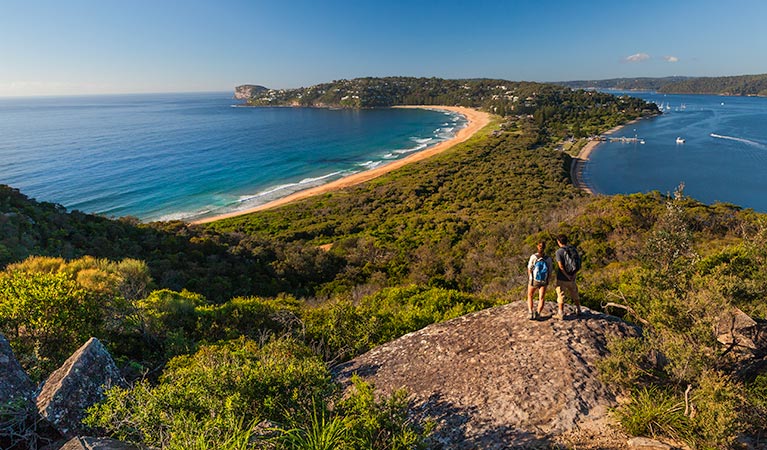Ku-ring-gai Chase National Park
Overview
Located in Sydney's north, Ku-ring-gai Chase National Park combines important history with scenic beauty, making it perfect for school excursions. Bobbin Head is a great place for a family picnic, and parts of the park are ideal for cycling, fishing and bushwalking.
Read more about Ku-ring-gai Chase National Park
Australia’s second-oldest national park, Ku-ring-gai Chase National Park is a recreational favourite for locals and visitors alike. This large park, located in Sydney’s north, lets you feel at one with nature without leaving the Sydney metropolitan area. A heritage-listed park, it combines important history with scenic beauty.
Winding creeks and stretches of ocean meet rainforest and eucalypts, rocky cliffs and mangroves. Camp at The Basin or spend your time exploring walking tracks, mountain biking trails, breathtaking lookouts and significant Aboriginal sites. You’ll still have plenty of time to discover its marinas, cafes, kiosks and well-equipped picnic areas.
Local alerts
For the latest updates on fires, closures and other alerts in this area, see https://www.nationalparks.nsw.gov.au/visit-a-park/parks/kuringgai-chase-national-park/local-alerts
Map
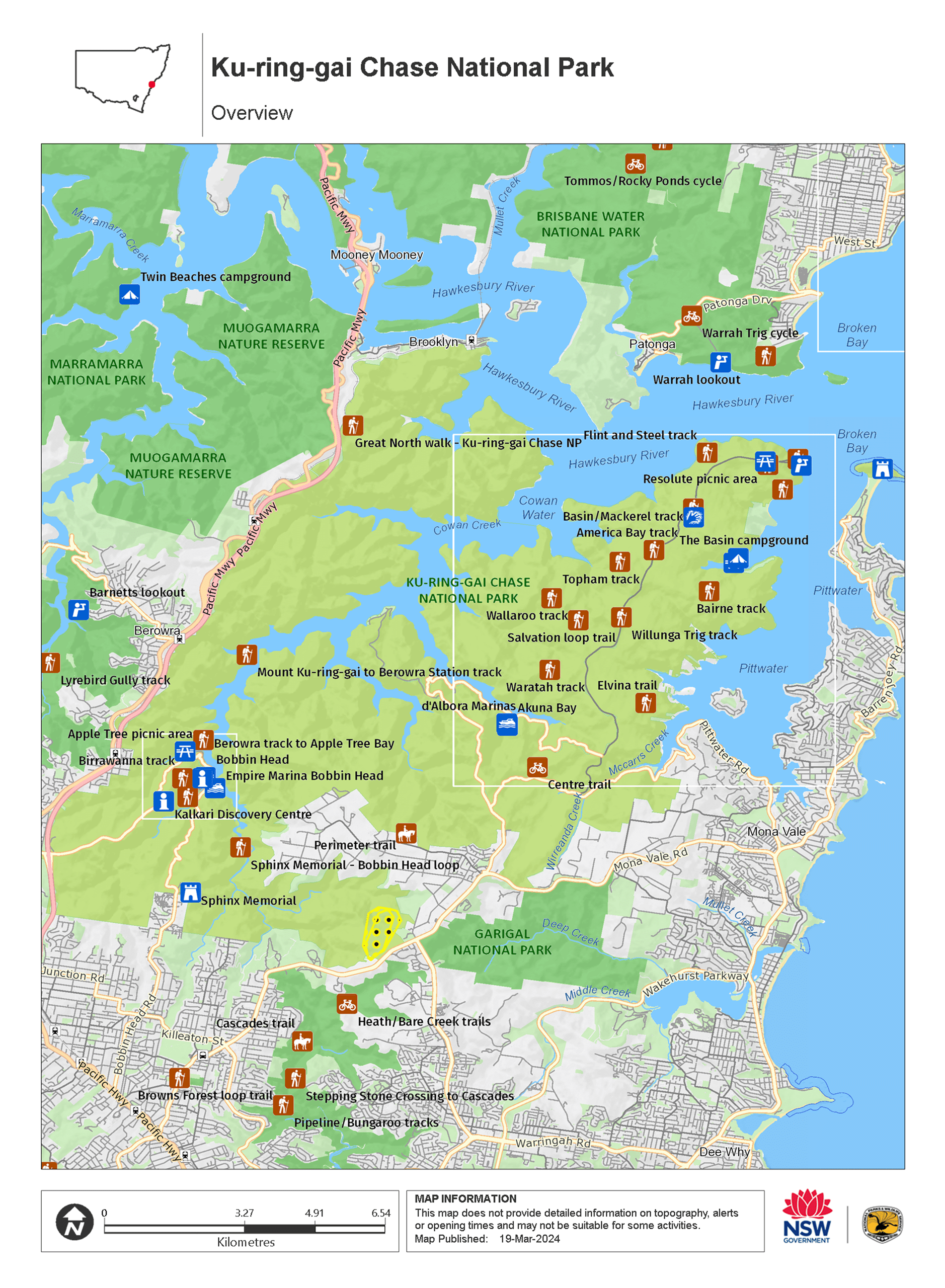
Map
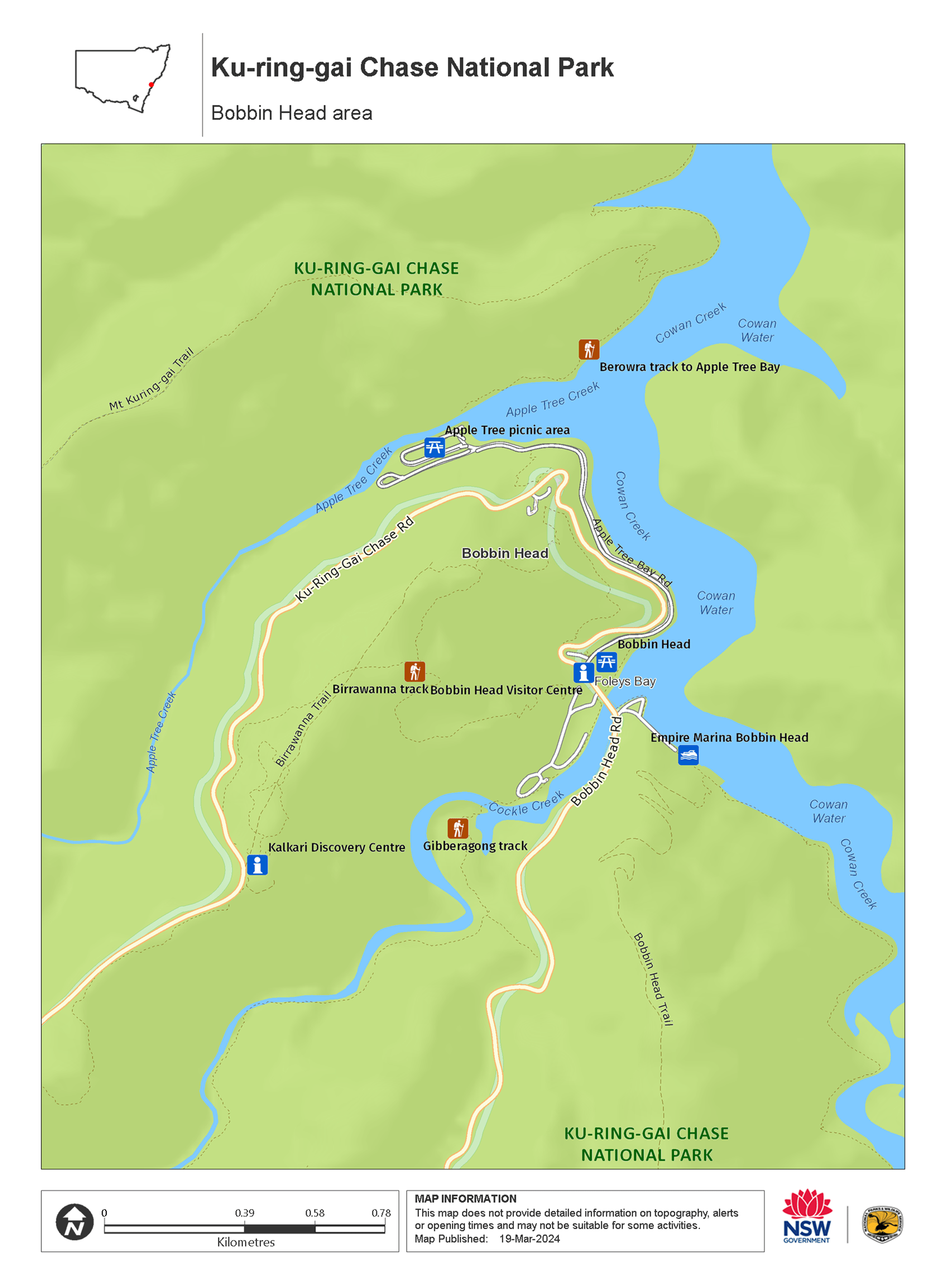
Map
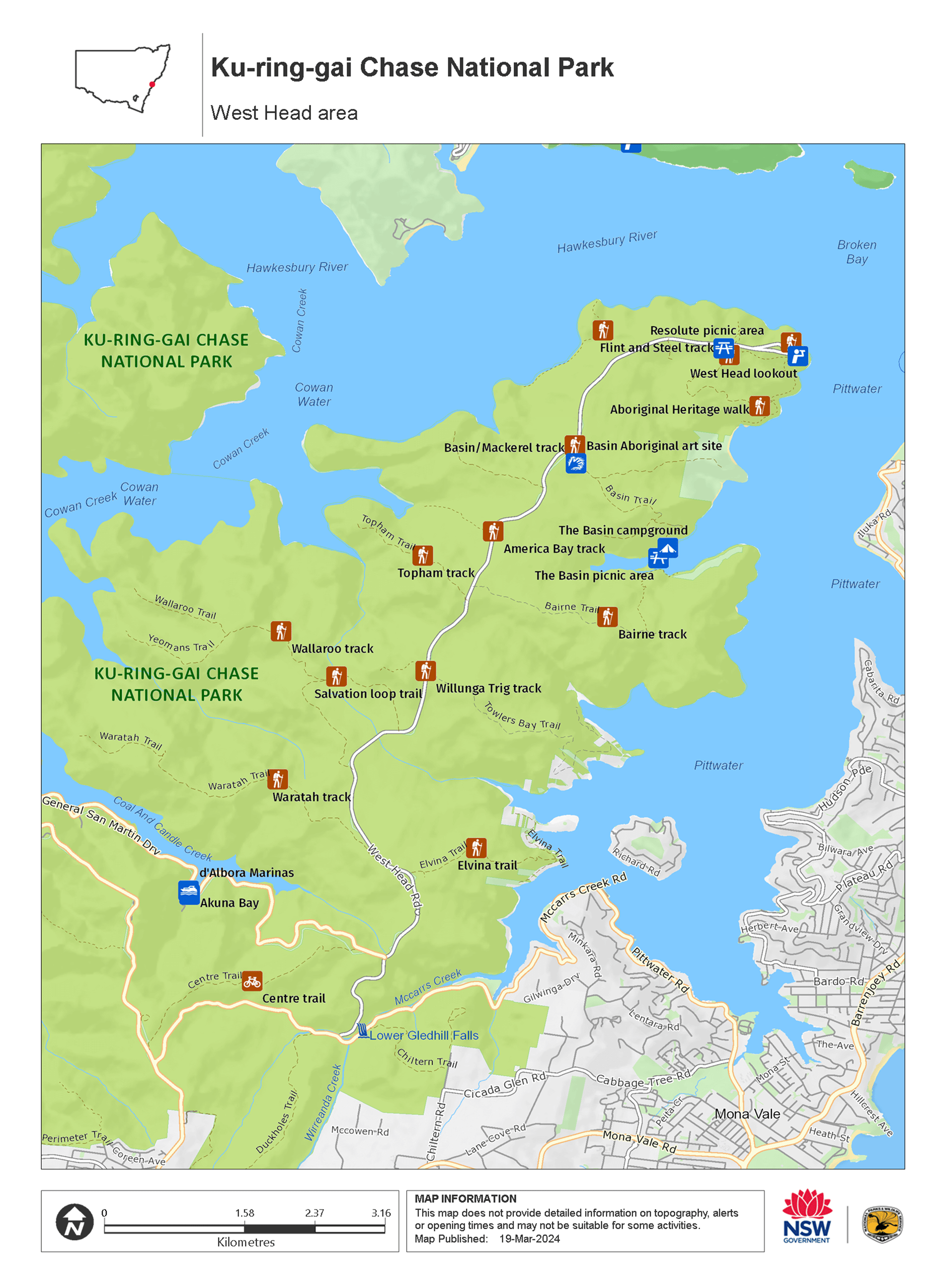
Map legend

Contact
- in the Sydney and surrounds region
Ku-ring-gai Chase National Park is open sunrise to sunset but may have to close at times due to poor weather or fire danger.
- The entrance to Bobbin Head and Appletree Bay is closed from 8pm to 6am during daylight savings periods, and from 5.30pm to 6am the rest of the year.
- Gates to West Head are closed from 8.30pm to 6am during daylight savings periods, and from 6pm to 6am the rest of the year.
-
Park entry fees:
$12 per vehicle per day. You can also pay for your visit via the Park’nPay app.
Vehicles over 8 seats: $4.40 per adult, $2.20 per child (per day). Students on educational programs: $1.10 per student. Teachers/educational supervisors: free (1 adult per 10 students).
Other fees:
A $3 per adult, $2 per child landing fee may apply for day visitors to The Basin campground. Please pay at the campground wharf. Landing fees are included in your camping fees.
Group bookings:
Under the Plan of Management for this park, prior written approval is required for organised groups of 40 or more people planning to visit this park. Contact the park office before your visit.
Buy annual pass. -
-
Bobbin Head Visitor Centre
02 9472 8949
Contact hours: 10am to 4pm daily. 9am to 4pm during summer school holidays, closed 12pm-12:30pm. Closed Christmas Day. - 688 Ku-ring-gai Chase Road, Mount Colah, NSW 2079
-
Email: bobbin.head@environment.nsw.gov.au
-
Bobbin Head Visitor Centre
Visitor info
All the practical information you need to know about Ku-ring-gai Chase National Park.
Getting there and parking
Get driving directions
From Turramurra:
- Enter the park from Bobbin Head Road, at North Turramurra.
- This is a good route to Bobbin Head and Appletree Bay.
From Mt Colah or Asquith:
- Enter the park from Ku-ring-gai Chase Road, off the Pacific Motorway. Or from Belmont Parade if you are driving from Mount Colah.
- This gives you easy access to the large parking areas and picnic facilities at Bobbin Head and Appletree Bay.
From Terrey Hills or Church Point:
- Enter the park from McCarrs Creek Road.
- This leads to Liberator General San Martin Drive, where you'll find the picnic areas and facilities of Illawong Bay and Akuna Bay.
- It also gives access to West Head Road, West Head.
Please note, you cannot reach The Basin campground or Barrenjoey Lighthouse directly by car.
Parking Show more
- Apple Tree picnic area See on map
- Basin Aboriginal art site See on map
- Bobbin Head Visitor Centre See on map
- d'Albora Akuna Bay See on map
- Elvina trail See on map
- Flint and Steel track See on map
Road quality
- Sealed roads
Vehicle access
- 2WD vehicles
By bike
Check out the Bicycle information for NSW website for more information.
By public transport
For information about public transport options, visit the NSW transport info website.
Best times to visit
Ku-ring-gai Chase National Park offers an exceptional visit all year round. You're sure to find a walk, tour, activity or attraction to appeal, regardless of the season.
Spring
If you're interested in wildflower displays, set aside a day in August or September to stroll through the park's blooming heathlands.
Summer
Bring your fishing gear and go camping at The Basin.
Winter
Barrenjoey Head (on the other side of Pittwater, but still in the park) is an excellent spot for whale watching. Take the Barrenjoey Lighthouse Walk between May and August or celebrate International Lighthouse and Lightship Weekend in August.
Facilities
Boat moorings
- NSW National Parks provides free, courtesy moorings available to all recreational boat users on Cowan Waters in Ku-ring-gai Chase National Park.
- Domestic Commercial Vessels may use courtesy moorings with NPWS consent.
- Vessels must not be left unattended on a courtesy mooring.
- Only one vessel can be attached to each mooring at a time, for a maximum of 24 hours. Attaching other vessels to the moored vessel is not allowed.
- Vessels cannot exceed 14 metres in length.
- There's no need to book, just moor your boat at any of the available yellow buoys marked with a NSW National Parks logo.
- There are 54 moorings in 17 locations and the NPWS mooring locations are shown as a black number inside a yellow circle on this map provided by Department of Roads and Maritime Safety.
Amenities
- d'Albora Akuna Bay
- Empire Marina Bobbin Head
- Kalkari Discovery Centre
- The Basin campground
- The Basin picnic area
Toilets Show more
- Apple Tree picnic area
- Birrawanna walking track
- Bobbin Head
- Bobbin Head Visitor Centre
- d'Albora Akuna Bay
- Empire Marina Bobbin Head
- Gibberagong walking track
- Great North walk – Ku-ring-gai Chase National Park
- Resolute picnic area
- The Basin campground
- The Basin picnic area
Picnic tables Show more
- Akuna Bay
- Apple Tree picnic area
- Bobbin Head
- Bobbin Head Visitor Centre
- d'Albora Akuna Bay
- Empire Marina Bobbin Head
- Gibberagong walking track
- Resolute picnic area
- Sphinx Memorial
- The Basin campground
- The Basin picnic area
Barbecue facilities Show more
Boat ramp
Cafe/kiosk
Drinking water Show more
- Apple Tree picnic area
- Bobbin Head
- d'Albora Akuna Bay
- Empire Marina Bobbin Head
- The Basin campground
- The Basin picnic area
Public phone
Showers
Maps and downloads
Fees and passes
Park entry fees:
$12 per vehicle per day. You can also pay for your visit via the Park’nPay app.
Vehicles over 8 seats: $4.40 per adult, $2.20 per child (per day). Students on educational programs: $1.10 per student. Teachers/educational supervisors: free (1 adult per 10 students).
Other fees:
A $3 per adult, $2 per child landing fee may apply for day visitors to The Basin campground. Please pay at the campground wharf. Landing fees are included in your camping fees.
Group bookings:
Under the Plan of Management for this park, prior written approval is required for organised groups of 40 or more people planning to visit this park. Contact the park office before your visit.
- All Parks Pass - For all parks in NSW (including Kosciuszko NP) $190 (1 year) / $335 (2 years)
- Multi Parks Pass - For all parks in NSW (except Kosciuszko) $65 (1 year) / $115 (2 years)
Annual passes and entry fees (https://www.nationalparks.nsw.gov.au/passes-and-fees)
Permitted
Fishing
A current NSW recreational fishing licence is required when fishing in all waters.
Please note that spear guns and hand spears are not permitted in Ku-ring-gai Chase National Park. They may not be carried through the park and must not be used within 100m of a beach in the national park.
Prohibited
For visitors holding a picnic or an approved event in this park, please note that the following is also prohibited:
- Amplified or loud music, or public address systems.
- Balloons, water balloons, or paintball equipment.
- Decorations consisting of flowers, vines or other exotic plant materials.
- Throwing of rice, confetti, petals or similar decorative items.
- Candles or other open flames.
- Tents and marquees. Please do not put up signage or cordon off structures picnic shelter areas.
Camp fires and solid fuel burners
Open fires and any form of solid fuel are not allowed.
Gathering firewood
Pets
Pets and domestic animals (other than certified assistance animals) are not permitted. Find out which regional parks allow dog walking and see the pets in parks policy for more information.
Smoking
NSW national parks are no smoking areas.
Visitor centre
-
Bobbin Head Visitor Centre
688 Ku-ring-gai Chase Road, Mount Colah, NSW 2079 - 10am to 4pm daily. 9am to 4pm during summer school holidays, closed 12pm-12:30pm. Closed Christmas Day.
- 02 9472 8949
-
-
Kalkari Discovery Centre
402 Ku-ring-gai Chase Road, Mount Colah NSW 2079 - 9:30am to 4:30pm. Closed on Christmas Day.
- 02 9472 9300
- 02 9472 9301
-
Kalkari Discovery Centre
Nearby towns
Hornsby (5 km)
A suburb in Sydney's upper north shore, Hornsby is conveniently located for easy access to Lane Cove National Park, Berowra Valley Regional Park, and the heritage-listed Ku-ring-gai Chase National Park - Australia's second-oldest national park. Explore walking and cycling tracks and Aboriginal sites, as well as marinas, cafes and picnic areas.
Sydney City Centre (26 km)
No trip to Sydney is complete without spending some time in the city’s beautiful parks. Whether it’s in central areas like Hyde Park or the Royal Botanic Gardens or further out in Centennial Parklands, there’s plenty of green space to go out and enjoy.
Gosford (50 km)
Gosford is a great destination for a family day trip or holiday. It's situated on Brisbane Water National Park and surrounded by state forests, lakes and beaches.
Learn more
Ku-ring-gai Chase National Park is a special place. Here are just some of the reasons why:
Brilliant for birdwatchers
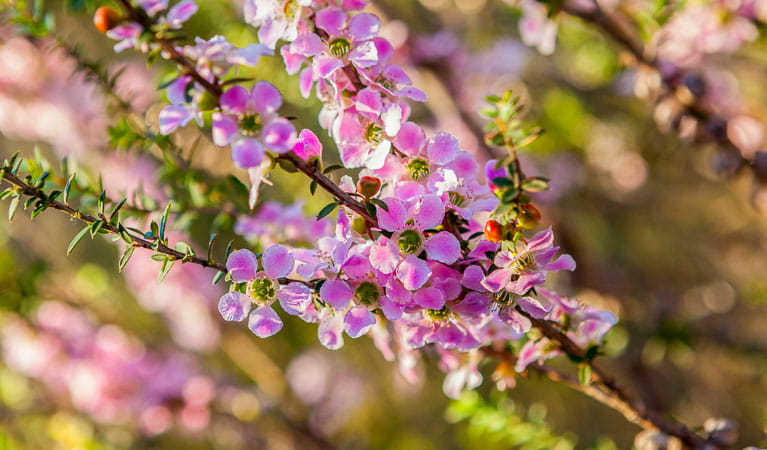
Over 160 bird species have been recorded in the park so bring those binoculars to see wood ducks, crimson rosellas, wedge-tailed eagles and pelicans. The Basin campground is home to some confident kookaburras, so keep a tight hold on your lunch.
- Explore Pittwater guided tour Explore the magic of Ku-ring-gai Chase National Park from the land and on the water when you join Pittwater Eco Adventures on this incredible tour.
- Waratah walking track The long, yet gentle, Waratah walking track takes in wildflowers and scenic water views over Akuna and Yeomens Bay in Ku-ring-gai Chase National Park.
A rich Aboriginal heritage
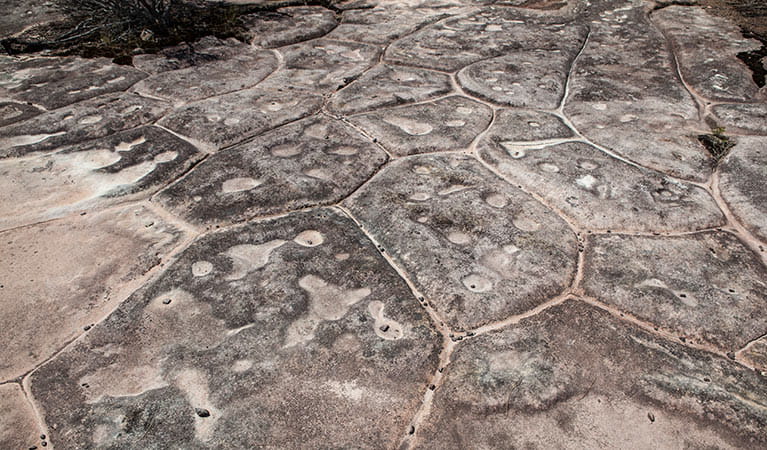
The park showcases the rich cultural heritage of the Aboriginal people who originally inhabited the area. More than 350 Aboriginal sites have been recorded in Ku-ring-gai Chase National Park. They include rock engravings, burial sites, axe grinding grooves and places that show evidence of Aboriginal occupation. For many visitors, these sites and other relics are the most visible reminders of the area's rich, living Aboriginal culture.
- Aboriginal cultural tours at The Basin Join Guringai Tours for a fascinating day of short walks with Traditional Custodians in beautiful Ku-ring-gai Chase National Park. It a great way to immerse yourself in Aboriginal culture near Sydney.
- Aboriginal Heritage walk Take the fascinating Aboriginal Heritage walk highlighting rock art and engravings of the Aboriginal people of West Head in Ku-ring-gai Chase National Park.
- Connecting to Country at Bobbin Head Click each point on the map to watch our video series. These stories share our Aboriginal cultural heritage and the importance of protecting the natural environment in Ku-ring-gai Chase National Park.
- Eco cruises at Pittwater and Broken Bay Sail around Pittwater and Broken Bay on an overnight journey with Eco Sailing Cruises. It's a unique way to explore the stunning beaches, walking tracks and lookouts of Ku-ring-gai Chase National Park.
- Ku-ring-gai Chase guided bushwalks Explore the highlights of beautiful Ku-ring-gai Chase National Park with the friendly guides of Go Beyond Tours. See wildlife and stunning scenery and discover Aboriginal heritage on this day tour near Sydney.
Wonderful waterways
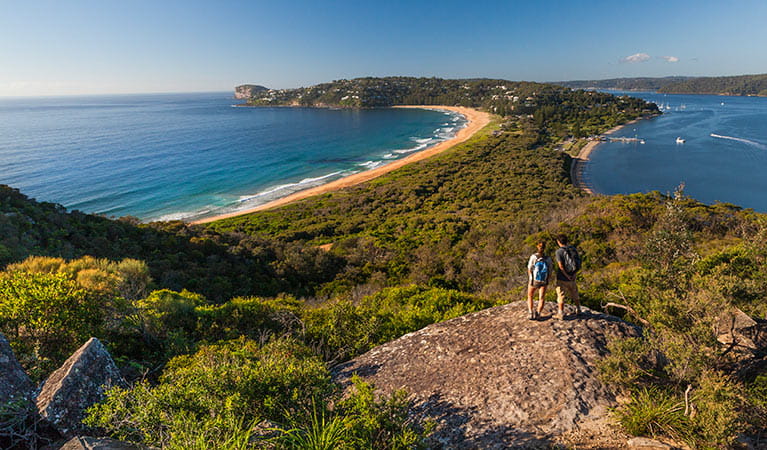
Protecting a major part of northern Sydney’s waterways, Ku-ring-gai Chase National Park is the ideal place to make a splash. The park includes much of the Hawkesbury River, Pittwater and Cowan Water, plus numerous creeks and coves. You’ll find good facilities at Empire Marina, amazing sea views at Barrenjoey Head and several good spots for a waterfront picnic.
- Eco cruises at Pittwater and Broken Bay Sail around Pittwater and Broken Bay on an overnight journey with Eco Sailing Cruises. It's a unique way to explore the stunning beaches, walking tracks and lookouts of Ku-ring-gai Chase National Park.
- Elvina trail Elvina trail in Ku-ring-gai Chase National Park is a pleasant walk from West Head Road down to Elvina Bay, with expansive views along the way.
- Explore Pittwater guided tour Explore the magic of Ku-ring-gai Chase National Park from the land and on the water when you join Pittwater Eco Adventures on this incredible tour.
- Great North walk stage 7: Hawkesbury panorama Stage 7 of the Great North walk shows off the spectacular diversity of Ku-ring-gai Chase National Park. Discover ridges and rainforests on the 13km walk from Cowan to Hawkesbury River stations.
- Ku-ring-gai corporate leadership experiences Unlock your team's leadership skills, increase wellbeing and reconnect with nature with Gone Bush Adventures. Your guides will take you on a tour in Ku-ring-gai Chase National Park that’s tailor-made to suit your team's requirements.
A great location to run, row or ride
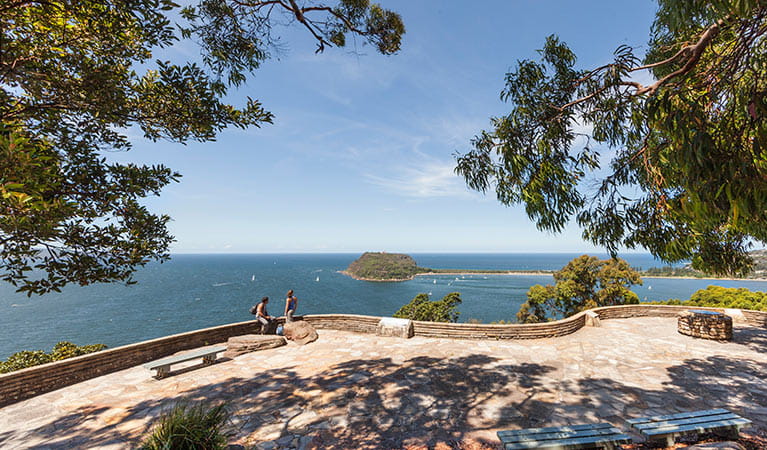
Ku-ring-gai Chase National Park is situated within the Sydney Metropolitan Area, 20km north of the Sydney CBD. The park runs from St Ives to the shores of the Hawkesbury River at Brooklyn. The 14,882ha park also includes the stunning Barrenjoey Head, 1km across Pittwater at Palm Beach. Multiple entry points offer easy access – one of the many reasons this park is so popular with locals. With everything from jogging tracks to picnic areas and great places to whalewatch, Ku-ring-gai Chase National Park is excellent for outdoor activity.
- Akuna Bay Boating enthusiasts love Akuna Bay. Use the public barbecue and enjoy a picnic at Akuna Bay Marina. It's the ideal spot to recharge after you've been out sailing.
- Bobbin Head Visit Bobbin Head picnic area in Ku-ring-gai Chase National Park and enjoy a barbecue or a spot of fishing for a great daytrip from Sydney.
- Deluxe camping experience at The Basin Enjoy a hassle-free getaway with help from the EcoTreasures camping set up service. They’ll pitch your tent at The Basin campground and provide all the gear you need for a peaceful and relaxed nature escape.
- Eco cruises at Pittwater and Broken Bay Sail around Pittwater and Broken Bay on an overnight journey with Eco Sailing Cruises. It's a unique way to explore the stunning beaches, walking tracks and lookouts of Ku-ring-gai Chase National Park.
- Hawkesbury farm-to-plate oyster tasting tours If you’re a seafood lover, venture out onto the Hawkesbury’s sparkling waters with Sydney Oyster Tours. You’ll taste delicious seafood and learn all about oyster cultivation.
Plants and animals protected in this park
Animals
-
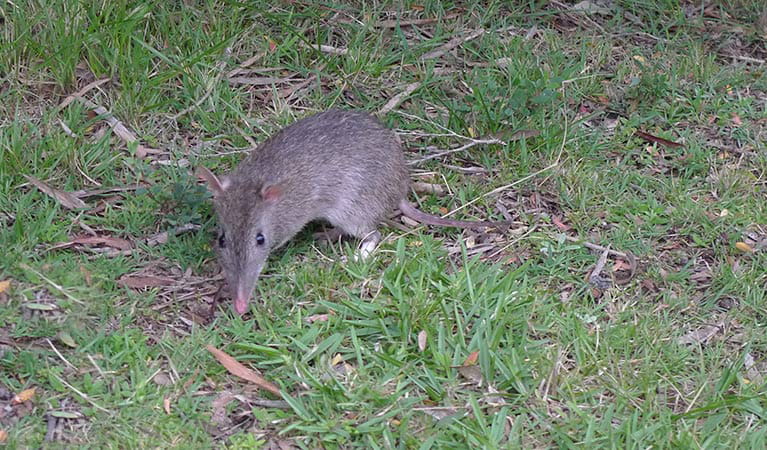
Long-nosed bandicoot (Perameles nasuta)
A nocturnal marsupial and one of the smaller Australian native animals, the long-nosed bandicoot is found across eastern Australia. Populations in the Sydney region have dwindled since European settlement, leaving only endangered colonies in inner western Sydney and at North Head, near Manly. The long-nosed bandicoot has grey-brown fur and a pointed snout which it uses to forage for worms and insects.
-

White-bellied sea eagle (Haliaeetus leucogaster)
White-bellied sea eagles can be easily identified by their white tail and dark grey wings. These raptors are often spotted cruising the coastal breezes throughout Australia, and make for some scenic bird watching. Powerful Australian birds of prey, they are known to mate for life, and return each year to the same nest to breed.
Plants
-
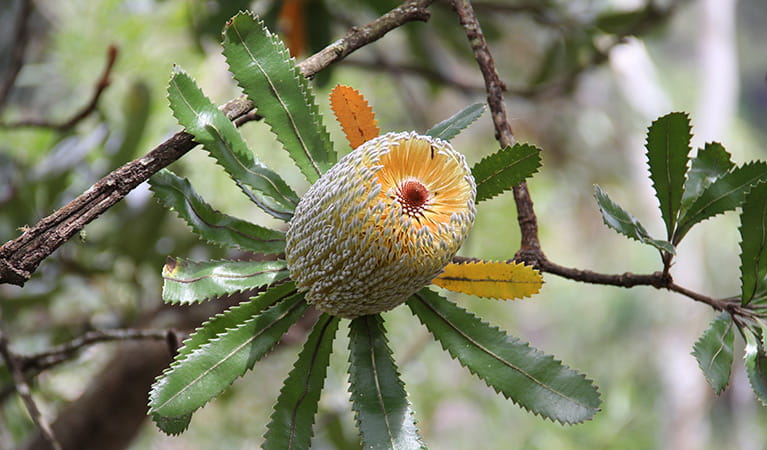
Old man banksia (Banksia serrata)
Hardy Australian native plants, old man banksias can be found along the coast, and in the dry sclerophyll forests and sandstone mountain ranges of NSW. With roughened bark and gnarled limbs, they produce a distinctive cylindrical yellow-green banksia flower which blossoms from summer to early autumn.
-

Grass tree (Xanthorrea spp.)
An iconic part of the Australian landscape, the grass tree is widespread across eastern NSW. These Australian native plants have a thick fire-blackened trunk and long spiked leaves. They are found in heath and open forests across eastern NSW. The grass tree grows 1-5m in height and produces striking white-flowered spikes which grow up to 1m long.
-
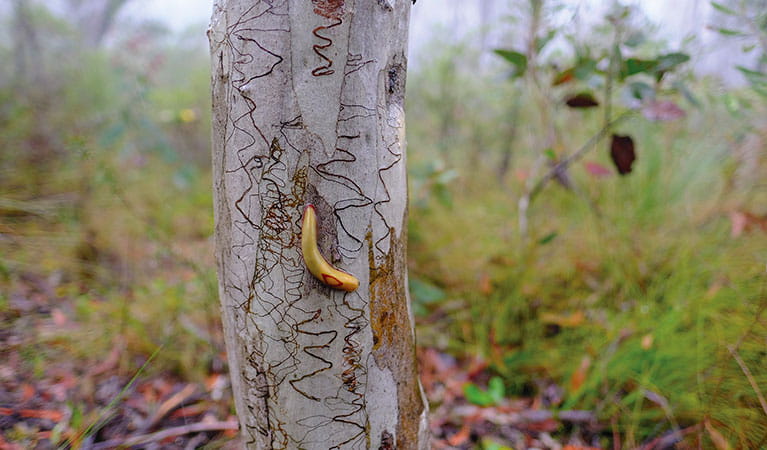
Scribbly gum (Eucalyptus haemastoma)
Easily identifiable Australian native plants, scribbly gum trees are found throughout NSW coastal plains and hills in the Sydney region. The most distinctive features of this eucalypt are the ‘scribbles’ made by moth larva as it tunnels between the layers of bark.
-
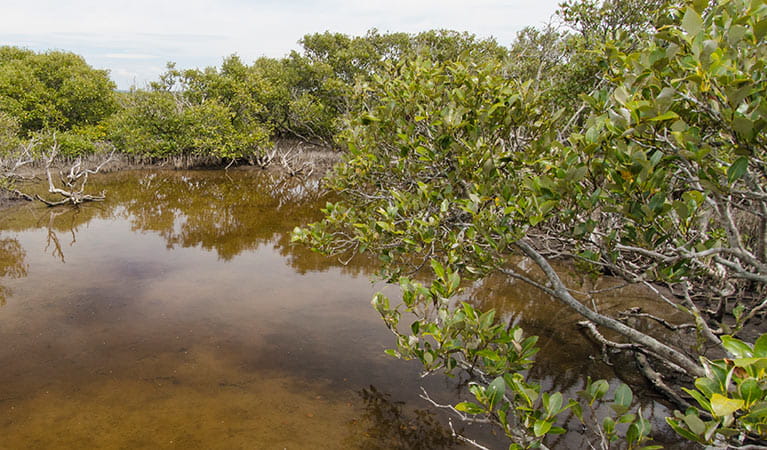
Grey mangrove (Avicennia marina)
Grey mangrove is the most common and widespread mangrove found within intertidal zones across Australia, and throughout the world. Growing to a height of 3-10m, they thrive best in estuaries with a mix of fresh and salt water. They excrete excess salt through their long thick leaves, and absorb oxygen through their aerial root system.
Environments in this park
Education resources (1)
What we're doing
Ku-ring-gai Chase National Park has management strategies in place to protect and conserve the values of this park. Visit the OEH website for detailed park and fire management documents. Here is just some of the work we’re doing to conserve these values:
Preserving biodiversity
NPWS works to monitor and help recover populations of plants and animals in Ku-ring-gai Chase National Park. Ongoing efforts to protect threatened, vulnerable and endangered species include observation, surveys, and distribution and population data collection. The park appreciates the public’s contribution to preserving its biodiversity. Volunteer programs take place in this park, and include seed planting and propagation.
Managing weeds, pest animals and other threats
Pests and weeds have a significant impact to ecosystems within Ku-ring-gai Chase National Park. Reduction of these threats, such as foxes, bitou bush and boneseed, as well as ongoing risk assessments for new and emerging weeds, is an important part of the work NPWS does to protect the biodiversity values of this park.
Historic heritage in our parks and reserves
Ku-ring-gai Chase National Park features notable historic heritage. Memorial sites within the park receive ongoing conservation work to preserve it for years to come, and the park undertakes routine maintenance and upgrading of all its facilities.
Developing visitor facilities and experiences
Ku-ring-gai Chase National Park offers some of the area’s best recreational activities, including kilometres of walking tracks and horse riding and mountain biking trails. NPWS undertakes regular maintenance of such infrastructure and facilities, and considers the addition of new ones where appropriate.
Conserving our Aboriginal culture
Ku-ring-gai Chase National Park is home to many Aboriginal sites. NPWS continues to monitor the conditions of Aboriginal sites in Ku-ring-gai to ensure that the culture of this park is preserved for years to come.
Managing fire
NSW is one of the most bushfire prone areas in the world as a result of our climate, weather systems, vegetation and the rugged terrain. NPWS is committed to maintaining natural and cultural heritage values and minimising the likelihood and impact of bushfires via a strategic program of fire research, fire planning, hazard reduction, highly trained rapid response firefighting crews and community alerts.

